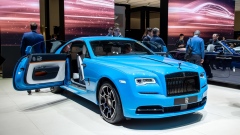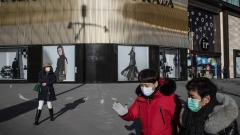Jun 12, 2018
The Art Fair Where $20 Million Impulse Buys Are the New Normal
, Bloomberg News
(Bloomberg) -- The premise of an art fair is that a collector can walk through its aisles, stumble across an artwork that catches her eye, and buy it. As a consequence, prices at most fairs are comparatively low, with work rarely surpassing the $2 million mark. After all, there are very few people who can afford a million-dollar impulse buy.
The one exception is at Art Basel in Switzerland (June 14–17), where dealers tend to bring showstopping art at a much higher price point.
“This was always the premier art fair of the world,” says Brett Gorvy, a co-founder of Lévy Gorvy, which has a 1982 collage by Jean-Michel Basquiat in its booth for $17.5 million and a painting by Mark Grotjahn on offer for $12.7 million. “It was always the tradition in Basel that [dealers] would ultimately hold their best work for the fair.”
But this year at Art Basel, which opened to VIPs on Tuesday and officially opens to the public on Thursday, there’s been a further upward trend in the price of many of the objects on view.
As a mishmash of European, American, and Asian collectors crowded into the fair on the opening morning, women with small watches and large bracelets mingled with men wearing large watches and small bracelets, and dealers stood inside booths where the total value of artworks on view could easily surpass $100 million.
“We know that in Basel we have the possibility to get close to an auction-like situation,” says the Hauser & Wirth partner Marc Payot, standing near a painting by Joan Mitchell that sold on the first day for $14 million. “We can ask a price, which is a big price for an important work, and there’s pressure” on the collector, Payot explains. “If Collector A doesn’t decide [immediately], then Collector B is interested—it’s like an auction.”
In past years $10 million-plus artworks were outliers and many pieces could be found for hundreds of thousands of dollars or less. This year, those “reasonably” priced works are still there, but they’re increasingly joined by a profusion of art with values well above $3 million. And that’s where the action is.
Dealers provided two explanations for this change in material and price point: First, that wealthy collectors are simply more interested in art that’s at the top of the market; and second, that the rich are getting richer, and can spend more on art than ever before.
Changing Taste
“During the last boom in 2007 and 2008, people were bringing a lot of great art but it was selling it at a lower price,” says Robert Delaney, a director of London’s Bernard Jacobson Gallery, which has a booth that features two massive paintings by Robert Motherwell priced at $10 million each.
That lower priced art—call it the mid-hundred thousand range—represented what people commonly think of as the “middle market,” says Delaney, and that’s the art that’s arguably gone out of favor, replaced with identifiably “important” 20th century artworks.
“While there were a lot of people buying a lot of that art last time, now there are a few very wealthy people buying art at a very high level,” he explains. “That’s why there’s more expensive stuff—that’s just where the market has gone.”
The trend is relatively recent, says Ales Ortuzar, a dealer who has the exhibition space Ortuzar Projects in New York. “I think there’s definitely been a shift from an interest in the primary market to a much broader interest in a secondary, historical market,” he says. Meaning there’s less glitzy new works by young contemporary artists, and more art changing hands by people already in the art historical canon along the lines of Picasso.
“Prices at auction reflect that, and you can see it here at the fair,” he says.
Whereas just a few years ago $20 million sales were “a rarity even at auction houses’ evening sales,” Ortuzar continues, “now it’s a regular occurrence to sell a work at that range.”
Wealth Concentration Index
Another reason prices are higher could be that the rich, put simply, are richer. In 2017 alone, the world’s 500 richest people added $1 trillion to their net worth.
“The price of art is an index of wealth concentration,” says Marc Glimcher, the president of Pace Gallery. “Wealth concentration in this case doesn’t mean fewer, wealthier people,” he goes on to explain, but rather just how much each individual is able to accumulate for themselves. America is, for instance, minting more millionaires than ever before.
Standing in his booth surrounded by art that included a painting by Agnes Martin priced at $3.5 million and an Andy Warhol silkscreen of Judy Garland that Glimcher would only say was “a lot more than that” (both sold on the first day), he argues that the profusion of high-priced art was simply a sign that more galleries of more sizes are gaining confidence in their ability to sell multi-million dollar art.
Super high-end art “used to be material that we hid, because the prices, and the way that the exchange took place, could not bear public scrutiny,” he says. “And that’s no longer the case.”
No one raises an eyebrow, or gets outraged, if they hear about a $30 million sale at this point; 20 years ago, it would have been a different story.
Instead, Glimcher continues, “those high levels of the market are now functioning the way the middle levels of the market used to function—more credibly, more reproducibly, and slightly more transparently,” he says. “Or else you wouldn’t be seeing these [works] here.”
So will prices continue to rise?
“How expensive art gets is just a matter of how much wealth individuals can concentrate,” Glimcher says. “There’s no ceiling for a thing with no utility. But there’s no floor for a thing with no utility, either.”
To contact the author of this story: James Tarmy in New York at jtarmy@bloomberg.net
To contact the editor responsible for this story: Justin Ocean at jocean1@bloomberg.net
©2018 Bloomberg L.P.


